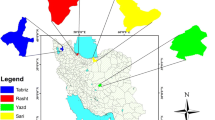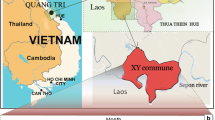Abstract
Rainwater harvesting gains more and more ground as a modern, relatively inexpensive and simple water-saving technology, and as a sustainable water management practice, which saves water, and reduces stormwater runoff and peaks and non-point source pollution. In this paper, in order to determine the optimal size of rainwater harvesting tanks, two methods, the daily water balance method and the dry period demand method, are used in 75 regions of Greece to meet 30, 40 and 50 % of total water demands of households of 3 to 5 residents. The daily water balance method was developed based on a heuristic algorithm which uses the daily rainfall data, the rainfall collection area, the runoff coefficient, the available storage volume and the water demands, allowing excess water to overflow and setting public water supply to zero. The dry period demand method is based on meeting demand for the longest annual average dry period. According to the daily water balance method, in the majority of the 75 regions studied, tank sizes up to 50 m3 can meet a 240 L/day demand (40 % of total daily demand of 4 residents) with roof area not exceeding 300 m2. More than 50 m3 tank size is needed to meet demands of 300 L/day (40 % of 5 or 50 % of 4 residents) or 375 L/day (50 % of 5 residents). Results demonstrate that the tank size is strongly affected by the dry period length; small dry periods lead to small tanks, with the exception of low rainfall-high demand (300–375 L/day) case, where low rainfall increases sizes, having the dominant role. Comparison among the dry period demand and the daily water balance methods showed that in all cases, the dry period demand method calculates smaller tanks, with the exception of areas with medium-high rainfall and high dry period or low-medium demand (135–225 L/day) and high roof areas (more than 300 m2). Therefore, the main conclusion is that the rainwater harvesting tank capacity is strongly affected by various local variables and cannot be formulated. However, the method presented here can be programmed in a spreadsheet with no much effort, making harvesting tank computations easy.



Similar content being viewed by others

References
Abdulla FA, Al-Shareef AW (2009) Roof rainwater harvesting systems for household water supply in Jordan. Desalination 243(1–3):195–207
Aladenola OO, Adeboye OB (2010) Assessing the potential for rainwater harvesting. Water Resour Manag 24(10):2129–2137
Al-Salaymeh A, Al-Khatib IA, Arafat HA (2011) Towards sustainable water quality: management of rainwater harvesting cisterns in Southern Palestine. Water Resour Manag 25(6):1721–1736
Appan A (1999) A dual-mode system for harnessing roofwater for non-potable uses. Urban Water 1:317–321
Basinger M, Montalto F, Lall U (2010) A rainwater harvesting system reliability model based on nonparametric stochastic rainfall generator. J Hydrol 392:105–118
Campisano A, Modica C (2012) Optimal sizing of storage tanks for domestic rainwater harvesting in Sicily. Resour Conserv Recycl 63:9–16
Chang N, Rivera BJ, Wanielista MP (2011) Optimal design for water conservation and energy savings using green roofs in a green building under mixed uncertainties. J Clean Prod 19:1180–1188
Chiu Y, Liaw C, Chen L (2009) Optimizing rainwater harvesting systems as an innovative approach to saving energy in hilly communities. Renew Energy 34:492–498
Cowden JR, Watkins DW Jr, Mihelcic JR (2008) Stochastic rainfall modeling in West Africa: Parsimonious approaches for domestic rainwater harvesting assessment. J Hydrol 361:64–77
Despins C, Farahbakhsh K, Leidl C (2009) Assessment of rainwater quality from rainwater harvesting systems in Ontario, Canada. J Water Supply Res Technol AQUA 58(2):117–134
DIN 1989–1 (2002) Rainwater harvesting systems - Part 1: planning, installation, operation and maintenance. German Institute for Standardisation, Berlin
Dinesh KM, Shantanu G, Ankit P, Singh OP, Ravindranath R (2006) Rainwater harvesting in India: some critical issues for basin planning and research. Land Use and Water Resour Res 6(1):1–17
Domènech L, Saurí D (2011) A comparative appraisal of the use of rainwater harvesting in single and multi-family buildings of the Metropolitan Area of Barcelona (Spain): social experience, drinking water savings and economic costs. J Clean Prod 19:598–608
Eroksuz E, Rahman A (2010) Rainwater tanks in multi-unit buildings: a case study for three Australian cities. Resour Conserv Recycl 54:1449–52
Fewkes A (1999a) The use of rainwater for WC flushing: the field testing of a collection system. Build Environ 34:765–772
Fewkes A (1999b) Modelling the performance of rainwater collection systems: towards a generalized approach. Urban Water 1:323–333
Fewkes A, Butler D (2000) Simulating the performance of rainwater collection systems using behavioural models? Build Serv Eng Res Technol 21(2):99–106
Fooladman HR, Sepaskhah AR (2004) Economic analysis for the production of four grape cultivars using microcatchment water harvesting systems in Iran. J Arid Environ 58:525–533
Ghisi E (2010) Parameters influencing the sizing of rainwater tanks for use in houses. Water Resour Manag 24:2381–2403
Ghisi E, Ferreira DF (2007) Potential for potable water savings by using rainwater and greywater in a multi-story residential building in southern Brazil. Build Environ 42(4):2512–22
Ghisi E, Tavares DF, Rocha VL (2009) Rainwater harvesting in petrol stations in Brasília: potential for potable water savings and investment feasibility analysis. Resour Conserv Recycl 54:79–85
Gikas GD, Tsihrintzis VA (2012) Assessment of water quality of first-flush roof runoff and harvested rainwater, J Hydrol 466–467, 115–126 (http://dx.doi.org/10.1016/j.jhydrol.2012.08.020)
Guo Y, Baetz B (2007) Sizing of rainwater storage units for green building applications. J Hydrol Eng 12(2):197–205
Hajani E, Rahman A (2013) Effectiveness of rainwater harvesting system in peri-urban region: a case study for the greater Sydney. J Hydrol Environ Res 1(1):21–29
Handia L, Tembo JM, Mwiindwa C (2003) Potential of rainwater harvesting in urban Zambia. Phys Chem Earth 28:893–896
Imteaz MA, Shanableh A, Rahman A, Ahsan A (2011) Optimisation of rainwater tank design from large roofs: a case study in Melbourne, Australia. Resour Conserv Recycl 55:1022–1029
Caribbean Environmental Health Institute (2009) Rainwater catch it while you can. A Handbook on Rainwater Harvesting in the Caribbean. Funded by The United Nations Environment Program (UNEP) (http://www.caribank.org/uploads/2013/08/em-rainwater-handbook-caribbean.pdf)
Pacific (2009) Peak Water, China’s Water Crisis, Climate Change Impacts among Pressing Topics Examined by Pacific Institute. Pacific Institute press release, 13 January 2009. (http://www.pacinst.org/press_center/press_releases/worlds_water_0809.html
Jones MP, Hunt WF (2010) Performance of rainwater harvesting systems in the south eastern United States. Resour Conserv Recycl 54:623–629
Kahinda JM, Taigbenu AE, Boroto JR (2007) Domestic rainwater harvesting to improve water supply in rural South Africa. Phys Chem Earth 32:1050–1057
Kyriazopoulou J-M (2012) Special secretary for water project results for program measures and institutional framework for residential water saving. Residential Water Saving Action Plan. Workshop Athens, January 13, 2012. (in Greek)
Lariyah MS, Mohd Nor MD, Mohamed RZA, Zulkefli M, Amirah Hanim MP (2011) Application of water sensitive urban design at local scale in Kuala Lumpur. Proceedings of 12nd International Conference on Urban Drainage, 10–15 September, Porto Alegre, Brazil
Lee KT, Lee CD, Yang MS, Yu CC (2000) Probabilistic design of storage capacity for rainwater cistern systems. J Agric Eng Res 77(3):343–8
Li X, Gong J (2002) Compacted microcatchments with local earth materials for rainwater harvesting in the semiarid region of China. J Hydrol 257:134–144
Mitchell VG (2007) How important is the selection of computational analysis method to the accuracy of rainwater tank behavior modeling. Hydrol Process 21:2850–2861
Palla A, Gnecco I, Lanza LG, La Barbera P (2012) Performance analysis of domestic rainwater harvesting systems under various European climate zones. Resour Conserv Recycl 62:71–80
Sazakli E, Alexopoulos A, Leotsinidis M (2007) Rainwater harvesting. Quality assessment and utilization in Kefalonia Island, Greece. Water Res 41:2039–2047
Song MY, Han MY, Kim SR (2003) Considerations on the rainwater harvesting regulations. J Korean Society Water Wastewater 17(6):729–740
Song J, Han M, Kim T, Song J (2009) Rainwater harvesting as a sustainable water supply option in Banda Aceh. Desalination 248:233–240
Souza EL, Ghisi E (2012) Potable water savings by using rainwater for non-potable uses in houses. Water 4:607–628
Sturm M, Zimmermann M, Schütz K, Urban W, Hartung H (2009) Rainwater harvesting as an alternative water resource in rural sites in central northern Namibia. Phys Chem Earth 34:776–785
Su M, Lin C, Chang L, Kang J, Lin M (2009) A probabilistic approach to rainwater harvesting systems design and evaluation. Resour Conserv Recycl 53:393–399
Texas Water Development Board, 2005. The Texas Manual on Rainwater Harvesting. (3, edn), Austin, Texas
Tsihrintzis V, Baltas E (2013) Sizing of rainwater harvesting tank for in-house water supply. 13th International Conference on Environmental Science and Technology, Athens, Greece, 5–7 September 2013
Tsubo M, Walker S, Hensley M (2005) Quantifying risk for water harvesting under semi-arid conditions: part I. Rainfall intensity generation. Agric Water Manag 76:77–93
van der Sterren M, Rahman A, Dennis GR (2012) Rainwater harvesting systems in Australia. In: Voudouris K, Voutsa D (eds). Ecological Water Quality - Water Treatment and Reuse, InTech
Vialle C, Sablayrolles C, Lovera M, Huau M-C, Jacob S, Montrejaud-Vignoles M (2012) Water quality monitoring and hydraulic evaluation of a household roof runoff harvesting system in France. Water Resour Manag 26(8):2233–2241
Villareal EL, Dixon A (2005) Analysis of a rainwater collection system for domestic water supply in Ringdansen, Norrköping, Sweden. Build Environ 40:1174–1184
Wang C-H, Blackmore JM (2012) Supply–demand risk and resilience assessment for household rainwater harvesting in Melbourne, Australia. Water Resour Manag 26(15):4381–4396
Ward S, Memon A, Butler D (2011) Rainwater harvesting: model-based design evaluation. Water Sci Technol 61(1):85–96
Yaziz MI, Gunting H, Sapari N, Ghazali AW (1989) Variations in rainwater quality from roof catchments. Water Res 23(6):761–765
Zhang X, Hu M (2014) Effectiveness of rainwater harvesting in runoff volume reduction in a planned industrial Park, China. Water Resour Manag 28(3):671–682
Zhou Y, Shao W, Zhang T (2010) Analysis of a rainwater harvesting system for domestic water supply in Zhoushan, China. J Zhejiang Univ 11(5):342–348
ΕΕΑ (2009) Water resources across Europe—confronting water scarcity and drought, Report No 2/2009
Author information
Authors and Affiliations
Corresponding author
Rights and permissions
About this article
Cite this article
Londra, P.A., Theocharis, A.T., Baltas, E. et al. Optimal Sizing of Rainwater Harvesting Tanks for Domestic Use in Greece. Water Resour Manage 29, 4357–4377 (2015). https://doi.org/10.1007/s11269-015-1064-1
Received:
Accepted:
Published:
Issue Date:
DOI: https://doi.org/10.1007/s11269-015-1064-1



